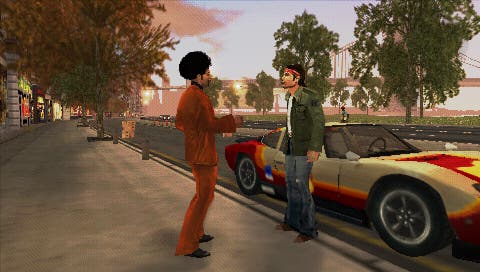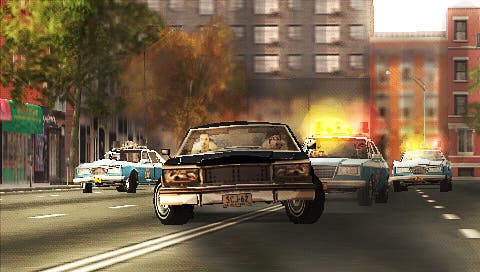Driver '76
Not a total write-off.
Having transformed its free-roaming motoring franchise into a Driv3r-shaped car crash of almost epic proportions, Atari attempted to put things straight with last year's Parallel Lines. Unfortunately the steering was still slightly off, and it wasn't quite enough to redeem a racing game that had become a write-off. Enter Ubisoft and $24 million dollars, and now, less than a year later, arrives the latest attempt to breathe life into the still-ailing brand: Driver 76. It's a prequel to the previous game, and as the title suggests, it dispenses with the dual-timeline structure of that game, sticking with New York in 1976 instead.
The semblance of a plot sees players take on the role of Ray, who fancies Chen-Chi, who happens to be the daughter of Triad boss Zhou. Cue a series of missions in which you try to win her affections by working your way up to impress her dad. This is the same open-ended city mission thing pioneered by the original GTA, taken into 3D by Driver, that GTA 3 took and improved by about a mile, before Parallel Lines shamelessly ripped it back off again. There's nothing new here that you've already seen a load of times in the GTA and Driver series.
Nevertheless, it's very polished (as you'd expect from a game developed by Sumo Digital), and the presentation values are superb throughout. The voice-acting is first class; the comic-strip cut-scenes work really well; and the 70s soundtrack is evocative and entertaining, featuring a range of hits encompassing the whole musical spectrum, from Debbie Harry to David Bowie, and even the song from the Marmite ads. The only blemish on this otherwise unspoiled façade is that the script and the narrative are both a bit duff in places (and isn't the word 'Chinaman' a racist slur these days?), but that's hardly a hugely serious handicap for a game in which the real substance is to be found in the city design and car handling.

And in both of those respects, Driver 76 acquits itself enormously well: there's a solidity to this New York that compares well to the open-ended cities featured in the handheld GTA titles. It's certainly as good a distillation of the real thing from Parallel Lines as you've any right to expect on the PSP. Likewise the handling is solid and satisfying, and the nuanced physics of the various different vehicles in the game is a testament to the quality of the game engine - and a special mention has to go to one of the most gratifying handbrake turns in videogames.
But yeah, this is still the same open-ended city mission thing that you'll have seen before, which means you've got to complete 27 career missions, all drawn from the familiar Driver/GTA school of mission design. You'll be ramming fish trucks and picking up hot cars and evading the cops. You'll be tailing vehicles, and you'll be driving carefully, or driving dangerously, depending on who's in your car. And you'll also be performing missions that contain successive sub-objectives, so you'll get frustrated when you get shafted by the random appearance of the cops, or by driving into a river you couldn't see, requiring you to perform the first six straightforward sub-objectives all over again.

Which isn't to say that these missions are badly designed, because they're not - and you don't have to drive across the city to trigger missions when you fail one. Instead, you simply select them from a menu, though there is the nagging feeling that this limits your freedom to roam around the city a little bit (though not entirely, because you're still free to drive around the city looking for hidden stars whenever you like). What is badly designed is the convoluted combat system, both in-car and on-foot. While driving, this sees you holding down the left trigger to aim, tapping it to select targets, and pulling the right trigger to shoot. It sounds simple enough, but while you're trying to tail an enemy it's a bit too much multitasking. When you're out of the car the same system requires less multitasking but it's equally clumsy and annoying.
Similarly, in spite of the impressive game engine, it's not quite perfect. Some of the glitches include: passengers who don't know when you're driving dangerously; difficulty getting in and out of cars; relatively empty streets; the occasional lamppost in the road; and cars that sometimes sink into the ground. To be fair to the game though, those are only cosmetic niggles, even though it might sound like a lot. And there's much more to do than just the career arc. In addition to driving round the city performing wild stunts and crazy leaps to pick off the remaining stars, it's also possible to participate in a series of side jobs to earn cash. You can then use that cash to upgrade your cars, or kit out a hideout. Which are actually both fairly superfluous, but they're also harmless enough if you're into that sort of thing.

There's also several ad hoc multiplayer modes, each of which are some variant on the various side jobs: there's the destruction derby Carnage mode, but the real fun is to be had in the three race modes, which admirably highlight the strength of the game's physics model. There's Point-to-Point races along labyrinthine lanes and alleys, or Street Races, and the excellent Circuit Races.
So it's all fine. It's a polished game that builds on its predecessor to continue the rehabilitation of the Driver brand. It's just that it hasn't really addressed the chief failing of Parallel Lines, which is that, as polished, and competent as it is, it still feels a bit like a soulless GTA clone.
